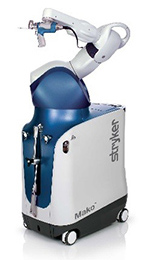Joint replacement may be an option for those suffering from knee or hip pain that limits the activities of daily living. Advancements in joint replacement technology are allowing a growing number of people in their 40’s and 50’s to become potential candidates for joint replacement surgery. This new technology enhances the level of precision in joint replacement and potentially reduces the percentage of patients that will require a revision surgery in their lifetime.
Who is a Candidate for Joint Replacement Surgery?
Joint pain can affect your every move, including walking, climbing stairs, sitting and sleeping. Those that suffer from joint pain may even have trouble rising from a chair, getting up from the bathroom seat or bending down to pick things up from the floor. If these and other activities of daily living are severely limited due to knee or hip pain, joint replacement surgery may be an option worth considering and discussing with your physician.
Joint replacement surgery is only recommended after examination and diagnosis of your particular joint problem, and only after conservative measures such as exercise, physical therapy and medications have proven ineffective to relieve your pain. 
Mako™ Technology
Mako™ Robotic-Arm Assisted Technology is an example of how technology is transforming the way joint replacement surgeries are being performed. Creating a virtual 3-D model, the Mako System allows surgeons to create each patient’s unique surgical plan pre-operatively before entering the operating room. During surgery, the surgeon can validate that plan and make any necessary adjustments while guiding the robotic-arm to execute that plan — bringing a new level of accuracy and precision to joint replacement surgery.
- Mako Partial Knee is designed to relieve pain caused by joint degeneration in one or two parts of the knee, usually the medial (inside half) or lateral (outside half). In partial knee replacement, the patient retains more of their own bone and ligaments than complete or total knee replacement. Partial knee replacement is often performed as an outpatient procedure, where patients go home on the same day of surgery.
- Mako Total Knee provides precision in placement of the implant and balancing of the soft tissue of the knee. Surgeons use Mako to create a personalized surgical plan and identify the implant size, orientation and alignment based on each patient’s unique anatomy.
- Mako Total Hip provides precision in placement and alignment of your implant — decreasing the risk of leg length discrepancy and chronic dislocation, which are concerns related to hip replacement surgery.
If you or someone you know is considering joint replacement and want to learn more, visit our section on Joint Replacement or call our joint care coordinate directly at (562) 933-4014.